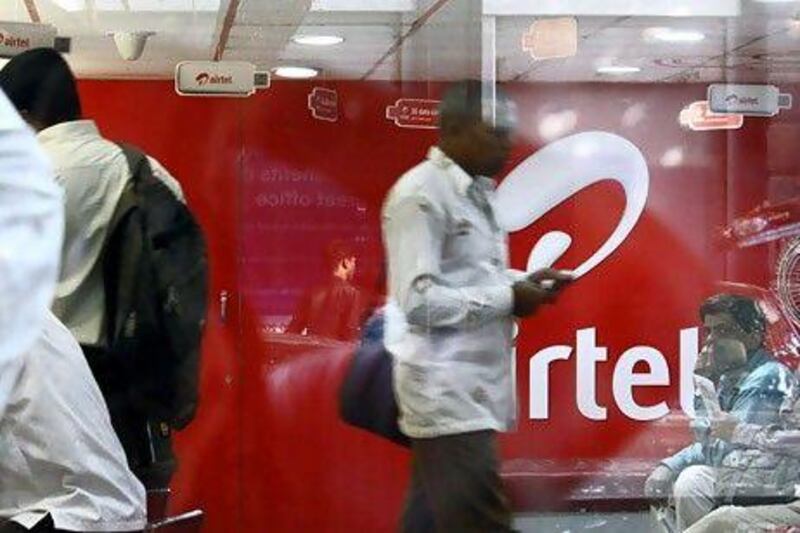India's love affair with mobile phones shows no sign of cooling. More and more users are joining the wireless revolution every day with countryside and cities alike racking up mobile numbers. There are now about 900 million mobile phones across the country.
No wonder businesses are trying to work out the next big thing. Location-based apps? Games? Video streaming?
But for many, the answer is mobile money.
Take Bharti Airtel, India's largest telecommunications operator. The company has launched a big advertising drive entitled "it is not just about money" for its mobile-money services. The campaign is hard to avoid as it is promoted via print, TV, outdoor and online media.
Bharti Airtel says mobile-payment operators have a huge opportunity in India because the majority of transactions are conducted in cash and bank accounts are not common.
"High-mobile penetration and limited banking facilities are driving the growth of mobile banking in rural markets," says Sriram Jagannathan, the chief executive at mCommerce, a unit of Bharti Airtel. "We see the national roll-out of Airtel money playing a pivotal role in accelerating mobile-based commerce in India and look forward to further extending the availability of this service in deeper pockets of the country in weeks to come."
Bharti Airtel cites other countries' success stories as examples.
Safaricom's M-Pesa in Kenya managed to find more than 6 million users in just two years, and the Philippines, too, has reported success with its mobile-payment systems. Airtel is not alone in pushing the trend in India. MasterCard, Visa and HDFC bank have all launched mobile-money services in the country.
According to Tavess Research, the number of mobile-money users in emerging markets is expected to reach 1 billion by 2015, with India alone expected to have more than 100 million subscribers by that date.
It is easy to see where all the excitement is coming from.
India's Associated Chambers of Commerce and Industry has predicted mobile penetration in the country will be 100 per cent by 2015. Cash is currently used for 67 per cent of all retail transactions.
Mobile-money applications use the mobile phone for payments and transfers instead of cash. Its proponents say mobile money is safer than cash since even if the phone gets stolen, the money is safeguarded by bank guarantees.
Industry analysts predict that the simpler the service offered, the more likely it will be to succeed.
"The mobile-payment models which will succeed in India are simple, interoperable solutions that solve a real consumer need and can apply to any handset, without the need for an upgrade in technology or additional equipment," says Mike Keyworth, the chief operating officer at Monitise, a mobile-payment technology company. "Crucially, mobile-payment models need to be interoperable so that they can work in conjunction with any merchant and are accepted by all parties.
"Those that have genuine and evident benefits such as helping consumers avoid queues when paying bills or send money to family members will secure the highest level of buy-in."
In addition to companies enthusing about the marvels of mobile commerce, India's government has said "financial inclusion" is essential in bringing the benefits of economic growth to everyone. As a result, the government has placed mobile payments high on its list of priorities.
But despite the enthusiasm for things mobile, India is a long way from being able to absorb the mobile-money revolution - as the Finnish handset giant Nokia has noticed, much to its chagrin.
The group, which launched its Nokia Money services with fanfare two years ago, announced at the end of last month that it was planning to pack in its money services.
"As a result of Nokia's evolving strategy and the business environment, we are exploring options for a structured exit from the mobile financial services business at Nokia, including our own-branded Nokia Money services," a company official said.
Nokia's plans were not short of ambition as it had planned to transfer its retail outlets into "cash points" to reach the millions of people who have no bank accounts. And in two years, Nokia was able to sign up 1.2 million customers. Of these, 1 million were on the Yes Bank and Union Bank platforms and the rest came through its own application.
Nokia's experience shows that the Indian market is not easy when it comes to mobile payments.
Mostly, the country lacks the necessary technology. Bringing 3G networks to the masses is still far off, especially in rural areas.
"Mobile payments are the future, but the infrastructure [and] the consumer behaviour are not there yet," says Katyayan Gupta, an analyst at the research company Forrester. "Connectivity in metro cities is good, but in the countryside it is still lacking. Mass adoption will take at least three years for supply and demand side to be ready.".
Cultural issues are also a big consideration.
Indians still rely heavily on traditional methods - cash, money orders and cheque remittances - when it comes to money transfers and payments.
"[The] Philippines is a very data-orientated country, but [in] India, voice still rules, especially in the rural areas," says Mr Gupta. "Indians are also much more conservative when it comes to money matters. People don't feel confident about transacting electronically. This is culture based on cash transactions."
Some industry watchers go as far as saying that talk of a mobile-payment revolution in India is just hype and that operators in the sector lack a real understanding of the market.
"The problem is that people don't understand the mobile world, understand the payment world and they do not look at what it costs to run the payment value chain in the banking world versus what it will cost to run it in the mobile world," says John Strand, the chief executive of the research company Strand Consulting.
"If mobile banking is to become a success in India, operators and banks will have to work together. Still, I don't believe that mobile payment will be a cash cow in India," says Mr Strand.





